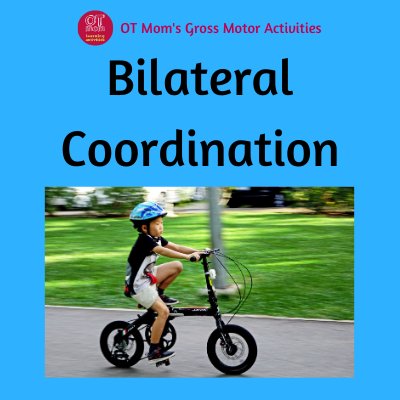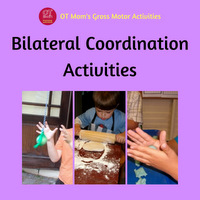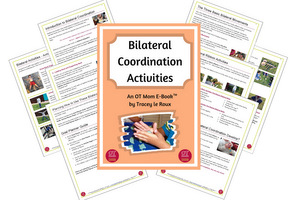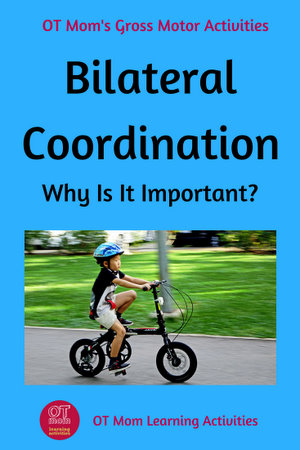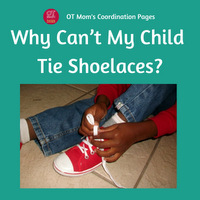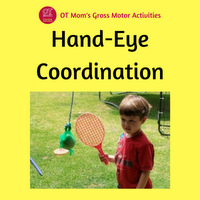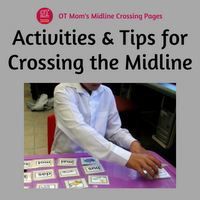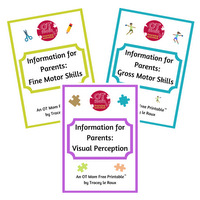- Home Page
- Coordination Skills for Kids
- Bilateral Coordination - Why It's Important
Bilateral Coordination
Bilateral coordination is the ability to use both sides of the body together in a coordinated way. It is also known as bilateral integration. Many childhood and school activities require your child to be able to use both hands together well.
I sometimes link to products (#Ad) that are similar to those I use and love. If you do purchase something through my links, I will receive a small commission that helps support my site - thank you!
A child who is delayed in developing bilateral coordination skills may prefer to use one hand alone rather than both hands together, and may appear awkward or clumsy in some gross and fine motor activities.
Studies have also found that there is a link between bilateral motor skills and academic performance. Some researchers suggest that bilateral exercises may stimulate the parts of the brain that are needed for thinking and for paying attention.
Tasks That Require Bilateral Coordination
Coordinated bilateral movements engage different sensory and motor areas on both hemispheres of the brain as well as the corpus callosum and cerebellum. Those parts of the brain work together to help to produce the complex bilateral movements that make up so much of our daily lives.
Below are just a few of the many activities that need both sides of the body to work together well. When bilateral integration is poor, then the child may avoid these activities, or the child may seem clumsy, inefficient and uncoordinated when taking part in them.
Some Gross Motor Activities That
Use Bilateral Coordination
- Jumping and skipping
- Riding a bike
- Catching a ball
- Swimming
- Beating a drum
- Pushing/pulling activities
- Sports
Some Fine Motor Activities That
Use Bilateral Coordination
- Tying shoelaces
- Threading beads
- Using a knife and fork
- Cutting with scissors
- Doing buttons
- Lacing activities
- Using a ruler to draw a line
The Three Basic Bilateral Movements
Your child needs to develop bilateral coordination skills in three different areas: symmetrical movements, reciprocal movements, and movements requiring a supporting hand.
Symmetrical bilateral movements are usually the first ones to be mastered, followed by reciprocal movements and lastly the asymmetrical movements of a leading and supporting hand. However, your child does not need to completely master one kind of movement before moving on to the next - there is a lot of overlap and interdependence in the development of coordination skills.
Here is a brief breakdown of each kind of bilateral movement:
1) Symmetrical Movements
Symmetrical movements have each leg or hand doing the same action at the same time, for example rolling out pastry with a rolling pin, pushing a wheelbarrow, or clapping hands.
It is important that both sides of the body do the same movement at the same time, with an equal amount of force.
 symmetrical bilateral movements
symmetrical bilateral movementsWatch out for: your child using one hand to do something that needs two hands, or having one hand doing more of the work, resulting in a lop-sided movement. In gross motor activities, watch out for one leg doing a better job or jumping/skipping etc than the other.
2) Reciprocal Movements
Reciprocal movements are actions where first one hand or leg and then the other carries out the same movement in a rhythmical way.
Examples would be pulling a rope hand-over-hand or pedaling a bike.
Reciprocal movements are also called alternating movements.
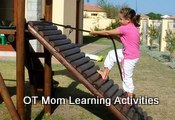 reciprocal bilateral movements
reciprocal bilateral movementsLook out for: movements which are jerky and don't flow well, or when one hand or leg does more work than the other, resulting in lop-sided action.
3) Leading Hand and Supporting Hand
We often use one hand to play a supporting role while the other hand does more skilled work, such as cutting with scissors, threading beads or drawing a line with a ruler.
Both hands are equally important, but one is specialising in tool use, and the other is specialising in assisting. Both hands need to work together smoothly in a coordinated way to ensure the task is completed well!
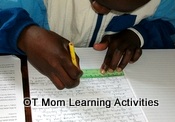 leading hand and supporting hand
leading hand and supporting handDuring handwriting, if a child does not stabilise the paper with the non-writing hand, then writing can be less efficient.
Watch out for: awkward positioning, where the supporting hand does not help the leading hand properly. During scissor cutting activities, check that the supporting hand is holding and moving the paper in such a way that the cutting hand can easily keep the scissors on the line. In some cases, the child may avoid using the supporting hand altogether!
If you are at all concerned about your child's development, please consult your health professional. The information on this page is not intended to take the place of an occupational therapy evaluation and treatment!
The Vestibular System and Bilateral Integration
The vestibular system (which is situated in the inner ear and helps the brain to process movement information) plays a vital role in a child's physical development.
Children who struggle to process movement information from their vestibular systems may also struggle with bilateral integration.
For this reason, occupational therapists who use sensory integration techniques may include specific movement activities in their therapy sessions to stimulate the vestibular system before carrying out activities to boost bilateral coordination skills.
At home, you can give your child's vestibular system a boost by having your child jump on a trampoline, roll on the grass, use a swing or do somersaults.
Help Your Child Develop Good Bilateral Coordination Skills
Now that you know what the different kinds of bilateral movements are, you can look out for ways of incorporating these into your child's daily routine.
1) Try the free activities on my site!
Check out a few outdoor and indoor activities that I have photographed with instructions.
Although symmetrical movements are often easier, your child does not have to master these before moving on to alternating movements – you can combine different kinds of movements through different activities.
Visit my page of free bilateral activities now!
2) Get my Printable Bilateral Coordination Resource!
If the free activities on my site are not enough, you may want to access my 55 page Bilateral Coordination Activities e-book! There are multiple pages of photographed activities in this printable resources!
Lots of variety and really practical ideas to make it easy for parents to work on these skills. All for the price of a couple of coffees!
View my Bilateral Coordination Activities E-Book now!
Thank you for visiting my site! I hope you found this information useful!
Why not sign up for my occasional newsletter to keep up to date with new activities and articles that I add?
- Home Page
- Coordination Skills for Kids
- Bilateral Coordination - Why It's Important
Share this page to help others!
Related Pages
References
- Buchele Harris, H.; Cortina, K.; Templin, T.; Colabianchi, N. and Chen, W. (2018). Impact of Coordinated-Bilateral Physical Activities on Attention and Concentration in School-Aged Children. BioMed Research International. 2018. 1-7. https://dx.doi.org/10.1155/2018/2539748
- Collmer, Katherine. Handwriting and the Non-Dominant Hand. 5 January 2016. (Retrieved 14 January 2016)
- Ivry, R.; Diedrichsen, J.; Spencer, R.; Hazeltine, E. and Semjen, A. (2004). A Cognitive Neuroscience Perspective on Bimanual Coordination and Interference. In: Swinnen, S.P.; and Duysens, J. (Eds) Neuro-Behavioral Determinants of Interlimb Coordination. Springer US. https://dx.doi.org/10.1007/978-1-4419-9056-3_10.
- Lane, S.; Mailloux, Z.; Schoen, S.; Bundy, A.; May-Benson, T.; Parham, L.; Roley, S. and Schaaf, R. (2019). Neural Foundations of Ayres Sensory Integration®. Brain Sciences. 9. 153. https://dx.doi.org/10.3390/brainsci9070153.
- Mailloux, Z.; Mulligan, S.; Smith Roley, S.; Blanche, E.; Cermak, S.; Coleman, G.G.; Bodison, S.; Lane, C.J. (2011). Verification and Clarification of Patterns of Sensory Integrative Dysfunction. AJOT. Vol.65 (2). https://dx.doi.org/10.5014/ajot.2011.000752
- Pacheco, S.; Gabbard, C.; Ries, L. and Bobbio, T. (2016). Relationship Between Interlimb Coordination and Academic Performance In Elementary School Children. Pediatrics International. 58. https://dx.doi.org/10.1111/ped.12972
- Parush, S.; Levanon-Erez, N., Weintraub, N. (1998) Ergonomic factors influencing handwriting performance. Work. 11(3) https://dx.doi.org/10.3233/WOR-1998-11306
- Wong, T.P.S.; Leung, E.Y.W.; Poon, C.Y.C.; Leung, C.Y.F. and Lau, B.P.H. (2013). Balance performance in children with unilateral and bilateral severe-to-profound-grade hearing impairment. Hong Kong Physiotherapy Journal. 31. 81–87. https://dx.doi.org/10.1016/j.hkpj.2013.07.001
Didn't find what you were looking for? Try a search of my site!
